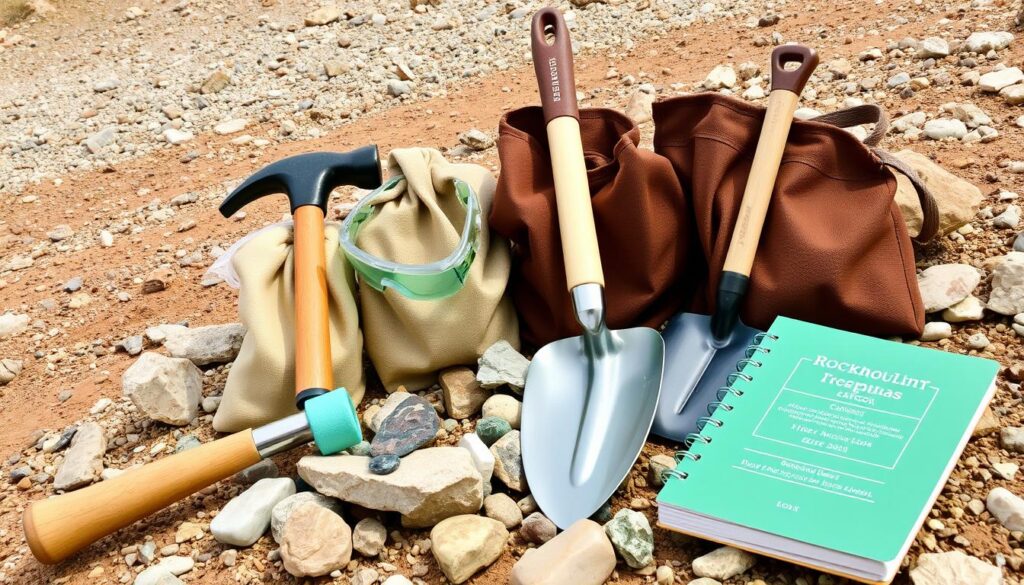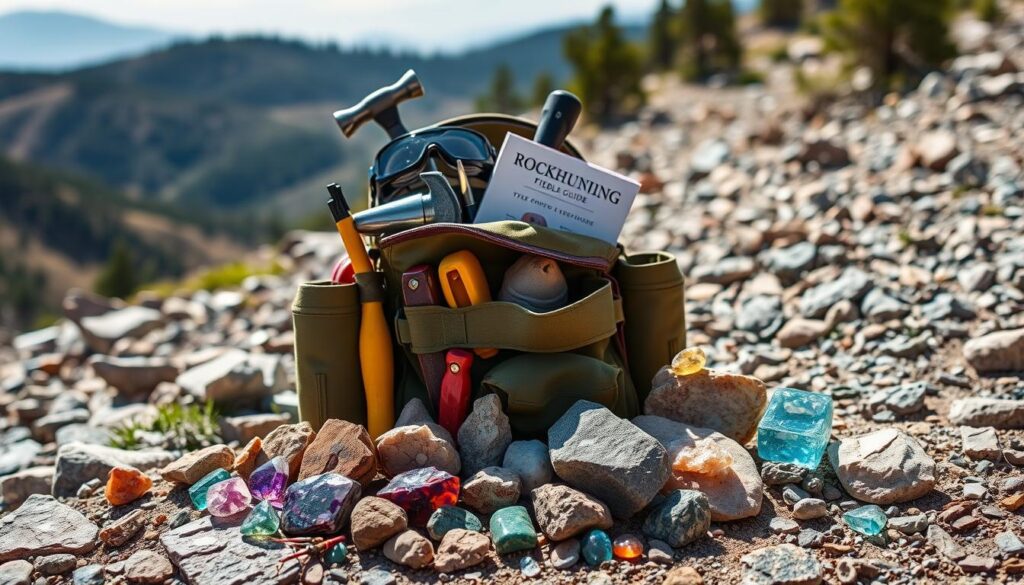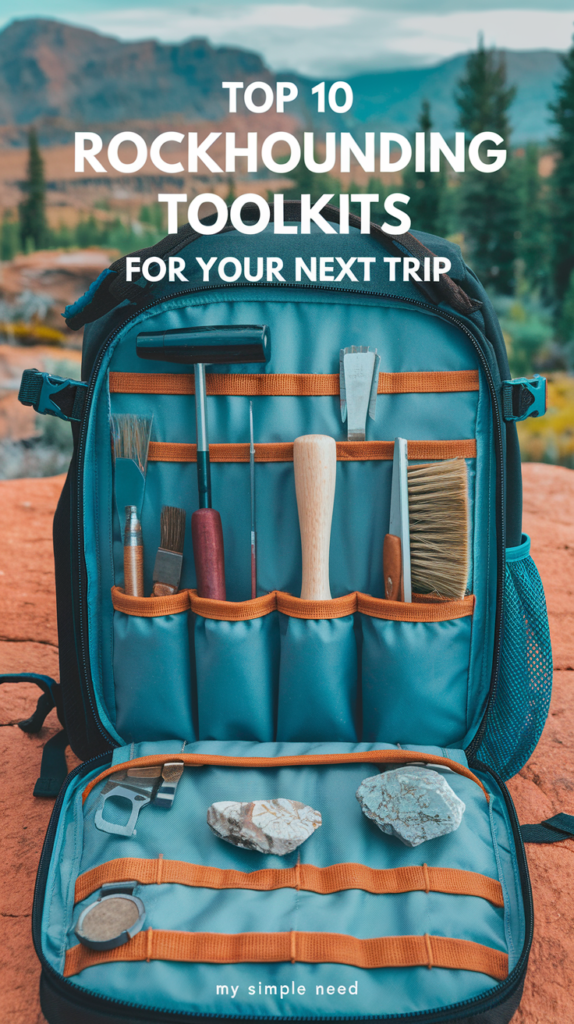Rock collecting fans know how key the right tools are. The best toolkits can turn any trip into a unique geological journey. Whether you’re new or experienced, the right gear is essential for finding and keeping amazing stones.
Rockhounding needs special tools, not just outdoor gear. A good rock hammer, sharp chisels, and safety glasses are basic. Both pros and hobbyists know that the right tools reveal hidden treasures in far-off places.

Gemstone Paydirt 8LB Bag
INCLUDES: 8lbs of gemstone paydirt, gemstone identification chart, and screening tips.
$39.99
Buy On Amazon* As an Amazon Associate I earn from qualifying purchases.

Gemstone Paydirt (2) 18LB Bag
(2) Motherlode 18lb Gemstone Paydirt, (2) Gemstone Identification Charts, (2) Gemstone Screening Tips
$154.99
Buy On Amazon* As an Amazon Associate I earn from qualifying purchases.

Gemstone Paydirt 18LB Bag
INCLUDES: 18lbs of gemstone paydirt, gemstone identification chart, and screening tips.
$84.99
Buy On Amazon* As an Amazon Associate I earn from qualifying purchases.
Key Takeaways
- Essential tools dramatically improve rock collecting success
- Safety equipment is crucial for protecting collectors
- Different terrains require specialized rockhounding toolkits
- Quality tools enable precise specimen extraction
- Investing in professional-grade equipment pays long-term dividends
Essential Components of Best Rockhounding Toolkits

Rockhounding needs a set of tools that can make a big difference. Each tool is important for safely collecting and keeping geological samples.
Professional Rock Hammers and Picks
Choosing the right rock pick is key for any serious rock collector. Geologists and hobbyists use special hammers to break and get rock samples without damage. A good rock pick should have:
- Durable forged steel head
- Comfortable ergonomic handle
- Balanced weight for precise strikes
- Shock-absorbing grip
Safety Equipment and Protective Gear
When exploring rocky areas, safety is top priority. Safety glasses are more than just an accessory; they’re essential. Good safety gear includes:
- Impact-resistant safety glasses
- Heavy-duty work gloves
- Steel-toed boots
- Protective hard hat
Storage Solutions and Bags
A strong collecting bag keeps your geological finds safe while moving. Rockhounds often choose bags that have:
- Reinforced compartments
- Padded interior to prevent specimen damage
- Water-resistant material
- Multiple pockets for tools and samples
Investing in top-notch rockhounding gear makes any trip an amazing geological adventure.

1 Pound Gold Paydirt
+ Free Glass Vial
Includes: 1 lb of Gold-Bearing Paydirt, 3mL glass vial and gold panning tips.
$39.99
Buy On Amazon* As an Amazon Associate I earn from qualifying purchases.

5 Pound Gold Paydirt
+ Free Glass Vial
Includes: 5 lbs of gold-bearing paydirt, 3mL glass vial and gold panning tips.
$154.99
Buy On Amazon* As an Amazon Associate I earn from qualifying purchases.

2.5 Pound Gold Paydirt
+ Free Glass Vial
Includes: 2.5 lbs of gold-bearing paydirt, 3mL glass vial and gold panning tips.
$79.99
Buy On Amazon* As an Amazon Associate I earn from qualifying purchases.
How to Choose the Right Rockhounding Equipment for Beginners
Starting a rockhounding adventure means picking the right gear. You need tools that fit your skill level and what you want to find. Beginners should choose their equipment wisely to have a good time and find cool rocks.
- Find tools that won’t break the bank
- Choose lightweight and easy-to-carry items
- Get versatile gear for different places
A good field guide is key for identifying rocks and understanding where they come from. Carry a strong backpack to hold your magnifying lens, rock hammer, and rocks you find. Your backpack should be comfy and have lots of pockets to keep things organized.
Here are some must-haves for beginners:
- A geological hammer
- Safety glasses
- A magnifying lens for looking at rocks closely
- Sturdy gloves
- Sample bags
Buy quality but affordable tools that will grow with you. A detailed field guide is essential. It teaches you how to identify rocks and gives insights into local geology.
Begin with basic, lightweight, and versatile tools. As you get better, add more specialized gear. This will match your interests and where you like to explore.
Professional-Grade Tools for Serious Rock Collectors
Serious rock collectors know that the right tools make a big difference. They turn simple rock collecting into a detailed science.
For advanced rock collectors, the right tools are key. They need tools that are precise and designed for their work.
Premium Rock Breaking Equipment
Top rock hammers are the best for getting rocks out. Serious collectors and geologists choose high-quality hammers and chisels. These tools work well and don’t damage the rocks.
- Titanium-head rock hammers with shock-absorbing handles
- Precision-engineered geological chisels
- Specialized carbide-tipped breaking tools

Advanced Specimen Extraction Tools
| Tool Type | Specific Use | Material |
|---|---|---|
| Micro-Extraction Chisel | Precise mineral removal | Hardened steel |
| Precision Splitting Wedge | Careful rock separation | Titanium alloy |
| Vibration-Dampening Hammer | Minimal specimen damage | Carbon fiber |
Specialized Cleaning Instruments
Cleaning rocks right is important after you get them. Professional collectors use special tools to clean and keep their rocks safe. They use bags that protect the rocks well.
- Ultrasonic cleaning devices
- Precision brushes and picks
- Chemical treatment solutions
Investing in professional-grade tools makes rock collecting a real science.
Budget-Friendly Complete Rockhounding Sets
Rockhounding doesn’t have to be expensive. You can find great toolkits that are affordable but still have everything you need. These toolkits are perfect for those who love rocks but don’t want to spend a lot.
When looking for cheap rock collecting gear, focus on the must-haves. A good budget toolkit should have:
- Durable rock pick with a comfortable grip
- Protective safety glasses
- Compact geological hammer
- Sturdy collection bag
- Basic chisels and measuring tools
Choosing the right budget toolkit is important. Look for ones that are both affordable and functional. Brands like Estwing and Geology Tools are great for beginners and casual collectors.
| Toolkit Brand | Price Range | Key Features |
|---|---|---|
| Beginner’s Rock Collector Set | $50-$75 | Rock pick, safety glasses, carry bag |
| Essential Rockhounding Kit | $75-$100 | Premium hammer, multiple chisels, protective gear |
| Value Geological Tool Set | $30-$50 | Basic tools, lightweight design |
Pro tip: Invest in quality safety glasses and a reliable rock pick—these are the most crucial components of any rockhounding toolkit.
Must-Have Features in Modern Rockhounding Gear
Choosing the right gear is key to a great rockhounding trip. Modern equipment needs to be both functional and user-friendly. It’s important to think about several key factors.
Rock collectors want gear that can handle tough outdoor conditions. It should also be practical and efficient. The best gear has a few essential features.
Durability and Material Quality
Good rockhounding gear can take a beating and still perform well. Experts suggest:
- Reinforced fabric for vest and backpack materials
- Shock-resistant tool handles
- Corrosion-resistant metal components
Portability and Weight Considerations
Lightweight gear makes exploring easier and longer. A good field guide and small tools help keep your pack light.
| Gear Component | Ideal Weight Range | Recommended Material |
|---|---|---|
| Rock Hammer | 14-22 ounces | Fiberglass or Carbon Fiber |
| Backpack | 2-4 pounds | Ripstop Nylon |
| Field Guide | 8-12 ounces | Waterproof Paper |
Versatility and Multi-purpose Tools
The best gear does more than one thing. Look for tools that can:
- Break rocks
- Collect specimens
- Provide immediate geological analysis
Investing in versatile, high-quality equipment makes any rockhounding trip unforgettable.
Final Thoughts
Finding the perfect rockhounding toolkit is a journey of passion and precision. It’s important for both beginners and seasoned collectors. Knowing what tools you need, like a rock hammer, safety glasses, and chisels, makes a big difference.
The best toolkits are about more than just tools. They’re about creating a great experience. They should be high-quality, functional, and let you explore freely.
Choosing durable tools that fit your skill level and goals makes your adventures safer and more fun.
Your toolkit shows your dedication to exploring the earth. Whether you’re using a strong rock hammer or carefully taking out delicate rocks, it matters. Both pros and hobbyists can find sets that offer versatility, safety, and the thrill of finding hidden treasures.
The best toolkit evolves with you. It should work well in different places and keep your curiosity alive. With the right tools, every rockhounding trip is a chance to learn and have fun.
FAQ
What are the most essential tools for a beginner rockhounding toolkit?
Beginners need a rock hammer, safety glasses, and a sturdy bag. A field guide, rock pick, and hand lens are also key. These tools help you collect and identify rocks safely.
How much should I expect to spend on a quality rockhounding toolkit?
A basic toolkit costs between and 0. Budget options start at , while top kits cost over 0. A mid-range kit, -0, offers great value for beginners.
Are there specific safety precautions I should take when rockhounding?
Always wear safety glasses and gloves. Choose sturdy boots and carry water. Bring a first-aid kit and tell someone where you are. Know local rock collecting rules.
What type of bag is best for carrying rock specimens?
A durable canvas bag or rockhounding vest is best. Look for reinforced bottoms and multiple pockets. Comfortable straps are important. Some prefer backpacks for extra protection.
How do I clean and maintain my rockhounding tools?
Clean tools after each use. Check for damage and oil metal parts to prevent rust. Store them dry and sharpen or replace as needed. Good care extends tool life.
What additional accessories should I consider for my rockhounding toolkit?
Think about adding a digital scale, marker pen, and notebook. A measuring tape, GPS, and magnifying lens are also useful. A field guide for your area helps with rock identification.
Can I use regular tools instead of specialized rockhounding equipment?
Basic tools can work, but specialized gear is better. It’s designed for rockhounding and keeps you safe. Investing in proper tools leads to better results and safety.
How do I choose the right rock hammer for my needs?
Choose a hammer based on your activities. Geological survey hammers differ from mining or quarrying tools. A 16-ounce hammer with a pointed pick is versatile for amateurs.

